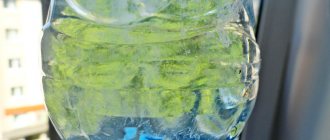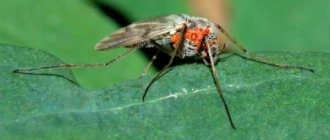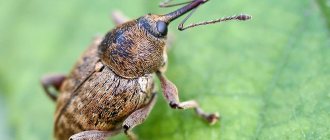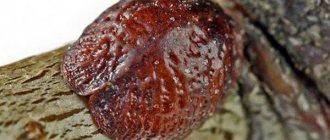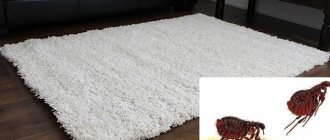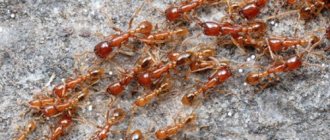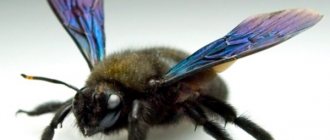Those wishing to feast on the fruits of man's labor appeared on the same day when man first stocked up on food. It is known that Ancient Rome and Egypt suffered from an invasion of granary beetles that spoiled grain reserves. Centuries have passed, but humanity still cannot get rid of such a parasite as the common barn weevil. To immediately recognize the parasite in a product, you should study its description and characteristics. And in order to understand how to combat it more effectively, it is necessary to find out methods of reproduction, preferred conditions and other information.
Granary weevil: description
Characterized by its small size (about 4 mm), the pest bug is distinguished by its dark brown, almost black color, narrow long body and the presence of wings. Such an insect is not adapted to flight, which does not prevent it from successfully moving over considerable distances with the help of humans. The granary weevil travels from continent to continent on ships carrying industrial grain shipments, and by land on trains and automobiles. How to get rid of such a dangerous insect?
The process of reproduction of such insects occurs during the warm period: the female, using a thin proboscis, gnaws a small hole in each grain (there are two in a corn grain), lays an egg in it, and then seals the crack with a stopper made of flour. This trick makes damaged grains practically indistinguishable from whole grains. You can spot the “trick” if you throw a handful of grains into the water: damaged (infested) specimens will float to the surface, while intact ones will sink to the bottom. Upon visual inspection, you can see that grains with larvae are an order of magnitude duller in color than undamaged ones.
Description
The weevil family has a total of more than 50 thousand species. The ones that settled closest to humans were the rice and granary weevils.
Barn beetle
has small dimensions (up to 4 mm), color: dark brown, wings are underdeveloped. The insect cannot fly, but this does not prevent it from spreading at great speed.
Pest of grains of wheat, barley, rye, rice (in some cases corn and buckwheat). With great success it settles in pasta and flour.
2.3-3.5 mm long, color: black-brown or dark brown, matte surface. Each elytron has two bright spots, strewn with specks and grooves; The beetle has hind wings and can fly perfectly.
It got its name because it was first discovered in rice. It also damages barley, wheat, flour, rye, corn, bran pasta, dried apples, crackers, cookies, bread, and even tobacco products.
Characteristic
The granary weevil is also called the grain weevil. This is an insect whose body does not exceed 5 mm. The size of the bug depends on the food it consumed during its development. The body shape resembles a slightly narrowed cylinder, the surface is shiny. The color of a broadmouth depends on its age. Thus, young individuals are colored light brown, while adults are almost black in color.
Barn weevil
The head of the weevil is very small, extended forward into a rostrum, at the end of which there is a mouthparts with which the grain weevil gnaws its food. The antennae located on the head are curved. The insect has wings: elytra with deep longitudinal grooves, membranous wings.
Interesting!
Despite the fact that the granary weevil is “equipped” with wings, it moves only with the help of its legs, since the development of the wings does not allow them to be used for these purposes.
Life cycle of the granary weevil
The fertility of one individual is 150-300 eggs with a life cycle of 3-4 months; males live a little longer, about 5 months. The duration of development of the larva (about 3 mm long, white, with a brown head) depends on temperature and humidity and is 3-6 weeks. One can only imagine how many thousands of pests just one pair of beetles can produce over the course of a year. At a temperature of +4°C, the larvae stop developing; at –5°C, they die. Upon completion of development, they turn into almost transparent, 3-5 mm long pupae. After 7 - 22 days, the formed beetles of the new generation gnaw a passage in the shell and leave the shelter outside. The average lifespan of an adult specimen is about 2 years. During the day, one larva destroys 0.08-0.67 mg of grain, gnawing out its internal contents; Accordingly, a massive number of these insects can destroy a significant amount of stocks.
How do they reproduce?
The process of reproduction of beetles is quite interesting; the female beetle gnaws a small hole in each grain, lays an egg there and, upon completion of the laying, seals the gap. Thus, the female lays up to 300 eggs. The pupation process occurs in this grain. The developed beetle gnaws a passage in the shell and leaves the shelter.
The whole mystery of the transformation of an egg into a larva, and then into a beetle, occurs in the grain, so we can only observe adult beetles.
Rice weevils are more fertile than barn weevils, so the female lays up to 500 eggs at a time. The laying process and the entire development process in these species of beetles proceeds identically.
Dear visitors, save this article on social networks. We publish very useful articles that will help you in your business. Share! Click!
A small and distant bug
The insect got its name due to the unusual shape of its head. Its front part resembles an elongated proboscis. With its help, the bug destroys the dense skin of grain or cereal.
In the natural environment, there are many species of weevils that destroy:
- grain crops;
- peas;
- buckwheat;
- rice;
- corn.
Therefore, the question of how to combat the grain weevil is being decided at the state level. Otherwise, the country may lose the harvest and famine will occur.
The beetle belongs to the Coleoptera family. Its maximum size is approximately 4 mm. The weevil is dark brown in color. Doesn't fly. The active life cycle of an adult lasts approximately 2 years. The female produces 3 or 4 generations per year. She lays eggs inside the grain, where they go through all stages of development.
In order for the individuals to come out, the adult beetles gnaw a hole in the grain.
She can lay approximately 300 eggs per season, which can damage a large amount of grain. Mass reproduction of pests leads to an increase in the temperature of the stored crop. The pest overwinters inside the grain or in various crevices of the room.
Recognized by appearance
Weevils, or elephant weevils as they are also called, belong to the family of the suborder of heterovorous beetles. There are 45 known species that are distributed throughout the planet. General signs: the head is elongated into the so-called rostrum, which is mistakenly considered a proboscis. In some varieties it is shorter than the body, in others it can be three times longer than the body. Jaws with strong tentacles, scales or shiny spines on the elytra. The larvae are cream or white in color, have no legs, and the body is curved in the shape of the letter “C”.
They are divided depending on the crops they feed on and damage: wood, apple, rice, pear, and so on. The grain weevil lays eggs inside the grain. It can start in ready-made flour, cereals and even pasta. Before you begin selecting a poison for extermination, you need to find out what a particular type of weevil is afraid of.
Destruction of beetles in kitchen supplies
How to deal with such a dangerous pest as the barn weevil? How to get rid of such a small but harmful insect in the barn and kitchen? In terms of household supplies, if a weevil is found in cereals, you should not eat the latter, because the secretions of insects and larvae contain carcinogens. Infected products must be thrown away, and a tough and possibly lengthy fight must be waged against the weevil.
It is recommended to store cereals in jars or hermetically sealed containers - not in bags, which the granary weevil (photo above) can easily gnaw through with its sharp teeth. Barn weevils are heat-loving creatures and die at low temperatures. Therefore, as one of the ways to get rid of bugs, you can use cold: place products that serve as potential food for weevils in the freezer. High temperatures also have a devastating effect on the tiny resident. Thus, at +40°C the granary weevil dies within 2 days, at +50°C – after 6 hours. After processing, food supplies should be placed in sealed containers with tight lids that are impenetrable to insects.
How to fight at home
If the weevil is found in cereals, it is not advisable to eat it, since the secretions of insects and larvae contain carcinogens. You should throw away the cereal and think about how to get weevils out of the kitchen.
- If you notice at least one bug in your kitchen, check all places and containers with cereals, flour, and pasta. Throw away any contaminated food found immediately.
- The weevil beetle has sharp enough teeth that it can easily gnaw through bags or bags of cereal, so store all bulk cereals in separate hermetically sealed containers or jars.
- Bugs are heat-loving insects. At a temperature of +5°C they fall into torpor, and when the air temperature drops to -5°C, all beetles, eggs and their larvae will die within a month. Use cold as a preventive measure. If you find a beetle in the kitchen, place everything that can serve as food for it in the freezer for 2-3 days; if it’s winter outside, just take it out to the balcony (quarantine).
- You can use the same method with products that you have just brought into your home from a store or market.
- You can also fight insects by heating. At a temperature of +40 °C, insects die within 2 days, increasing the temperature to +50 °C, the pests will die within 6 hours. You can get rid of insects by heating food products and cereals in the oven at a temperature of +50-60 °C.
- After processing, place the products in glass or plastic jars with tight lids through which insects cannot penetrate.
- Try fighting weevils with garlic. Peel but do not cut the garlic cloves. Place them in the container where you store cereals. Insects are repelled by odors.
- For prevention, regularly treat cabinets and cabinets where food products are stored with a soap solution with the addition of vinegar.
- Lavender flowers and bay leaves, which can simply be placed on shelves, will also help you in the fight.
- Do not make large stocks of cereals, flour and other products. Purchase them as you go. This will make it easier to monitor pest infestations and carry out prevention.
These simple tips will help you get rid of weevils in a fairly short time, and preventive measures will prevent their reappearance.
Advantages and disadvantages
The weevil is a creature extremely adapted to changing environmental conditions.
It feels comfortable in a temperature range of 16 to 28 degrees, but can tolerate more extreme temperatures. It is also not demanding of environmental humidity, since it spends most of its life inside the grain under the protection of its dense shell - exine. However, too dry air is destructive for most insects, including the weevil.
The duration of the beetle's life cycle depends on external conditions: the milder they are, the faster the insect reaches sexual maturity. If the temperature regime does not suit it, then the pest is able to fall into suspended animation and then return to a full life. Thus, the pest is capable of producing 2–3 generations during the year. Both beetles and larvae overwinter inside the grains. Also, adult insects feel good in crevices, cracks and other secluded places.
Read also: How to smoke lard: ways to smoke it correctly, recipes for smoked lard, benefits and harms
Together with damaged grain, as well as equipment, weevils migrate from one storage facility to another, damaging agricultural products.
Since man is forced to tolerate the presence of the weevil in his barns, he has developed a strategy to combat this pest. For prevention, the following means of control are used:
- cooling or, conversely, warming up grain and its processed products before storage;
- drying it out, because insects are critical to environmental humidity;
- cleaning grain from debris and impurities;
- cleaning of storage facilities and treatment by disinfestation. For this purpose, preparations based on hydrogen phosphorous (phosphine) are used, which are sprayed or used in the form of an aqueous solution;
- the use of ionizing radiation is at the development stage and may be used in the future.
The weevil grows not only in barns, but also in our homes. To prevent the beetle from spoiling our supplies, there are proven and harmless methods:
- place the cereal in the freezer for a while, and then pour it into sealed containers;
- since the insect does not tolerate strong odors, you can add peeled garlic cloves, bay leaves or lavender sprigs to the cereal;
- The cabinets where you store supplies must be washed with soap, soda or vinegar solution and ventilated well.
And finally, you shouldn’t stock up on cereals and pasta for half your life: fighting the harmful bug can become too long and exhausting at home.
Development
Lack of moisture inhibits the development of the weevil, and a humidity of 11% is detrimental to it.
In the southern regions, in the conditions of granaries, the granary weevil can produce 2-3 generations during the year, and in the central regions - 1-2. Beetles hibernate inside grains. Beetles can also overwinter in crevices and cracks in floors, walls, crawl spaces and other similar places.
Distributed with all types of damaged products. Especially often with warehouse equipment, grain cleaning machines that have not been cleared of old grain residues, and have not been destroyed with sweeps and unusable grain waste.
Barn weevil: control measures
In warehouses, it is very difficult to get rid of the barn weevil, because the insect hides in hard-to-reach places, and being inside the grains, it is practically invulnerable and can destroy from 10 to 30% of the harvested grain.
The fight against granary weevil consists of the following measures:
- Strong cooling of grain (down to -10°C), which can be used both for preventive purposes and in the process of destroying existing pests. Cooling is carried out in dry weather using ventilation and ventilation. This requires mandatory humidity control.
- You can partially get rid of the barn weevil by removing it on sieves with holes or using aspiration preparations. Any movement of the grain mass has a negative impact on the condition of harmful insects, reducing their numbers and development.
How to deal with grain weevil: wise advice from experts
Due to the fact that people have to endure the annoying bug in their storage units, they have come up with various options to combat it.
Preventive measures have a special effect:
- cleaning the crop from all kinds of impurities and debris;
- warming up;
- cooling the grain before sending it to storage at a temperature;
- maximum drying of the product;
- thorough cleaning of the premises;
- disinfection of storage with special preparations.
If the barn is small, beetles are driven away with the help of fragrant plants. It could be lavender, garlic or regular bay leaf. Let's take a closer look at how to deal with grain weevils in order to preserve the crop until the next season.
Periodic movement of grain into storage has a detrimental effect on the development of pest larvae.
Cleanliness is a reliable protector against pests
Before putting grain into storage, it must be thoroughly cleaned of debris. A small amount of the crop is carefully inspected, removing weeds and large husks. A large volume of grain is cleaned mechanically. Thanks to this treatment, the chance to protect the product from beetle invasion increases.
An important control measure for granary weevil is humidity control and ventilation of the granary. It should always be dry and have enough fresh air. If necessary, the room is treated with chemicals.
The following options are available for sale:
Most often, hydrogen phosphide is used, which is sprayed throughout the storage area. For small spaces, the drug is used in liquid form.
If grain is stored in containers, they also need to be disinfected and cleared of debris.
"Ambulance" tablets
To protect the crop from annoying pests, scientists have created a special drug. Practice has shown that tablets against weevils in grain are an effective means of combating the pest. However, before using them, you must carefully read the instructions for use.
If grain is poured into a hopper, tablets are added as it moves quickly and quite sharply. To ensure protection of the product stored in bags, the drug is placed around them in small portions.
How to get rid of weevils on your property
Weevil on strawberry
The strawberry weevil is a gray-black long-proboscis bug up to 3 mm in size. In the spring, individuals mate in flower buds, in which the larvae then develop. How to deal with weevils on strawberries? Today, there are many ways to destroy the pest, which can save up to 40% of the crop even with total damage. The sooner you start your fight against the beetle, the more chances you have to emerge victorious.
- Ants are not garden nurses
In the spring, when the air temperature is uncomfortable for the pest, treat the area with strawberries with the following means:
- iodine solution - dilute a teaspoon of iodine in a bucket of water;
- dissolve 3 Intra-vir weevil tablets in 10 liters of water.
Carry out the first treatment 5-6 days before the start of flowering, the next time spraying is carried out in mid-summer. Biological preparations Antonem-F and Namabact can be used to process strawberries or garden strawberries. Until the end of spring, it is permissible to use the drugs Fitoverm, Iskra-bio and Akarin. It is advisable not to resort to stronger means, for example, insecticides such as Karbofos, Actellik and Metaphos.
Cherry weevil
The cherry weevil, also known as the cherry trumpet weevil, also known as the cherry weevil, affects not only cherry trees, but also cherry, plum, apricot, cherry plum and even hawthorn trees. This is a golden-green bug, 5.5 to 10 mm long, with a purple metallic tint. The larvae are white, dotted with sparse red hairs, with a brown head and brown mouthparts.
Weevils cause damage to the generative organs of stone fruit crops even before sap flow begins - tree buds dry out and crumble. An invasion of the cherry borer can lead not only to loss of fruit yield, but due to the death of leaves, the trees themselves may also perish.
The fight against the cherry weevil should be carried out by all possible means - preventive, agrotechnical, folk, biological, and if necessary, then chemical:
- in the fall, clean the tree trunks of old exfoliated bark, then burn the plant remains and clean the trunks with a solution of lime;
- Also remove fallen leaves from under the trees into a compost heap or burn them;
- Be sure to dig up the soil in the tree trunks;
- during the period of swelling of the buds, shake off the beetles onto white paper or cloth spread under the tree and destroy them;
- during fruit ripening, collect and destroy carrion so that the larvae do not go into the soil;
- immediately after flowering, if you find more than 8 beetles on the tree, treat it with any of the chemicals we described.
Plum weevil
This bronze-colored bug with a metallic sheen, up to 45 mm long, all covered with short thick hairs, is also called the copper pipe worm due to its appearance. Not only plums suffer from it, but also thorns, apricots, cherries, sweet cherries, and sometimes apple trees, hawthorns, rowan berries and even currants. Harm is caused both by adult insects, which consistently damage buds, buds, flowers, pedicels, young fruits and leaves, and by larvae that develop in fruits.
The fight against copper pipeweevil is carried out in the same ways as against the cherry weevil, and among the chemical preparations, pyrethroids and organophosphorus compounds are most effective against it - for example, Actellik, Fufanon or Bazudin.
Raspberry weevil
Raspberries are damaged by the same type of weevil as garden strawberries, and the main damage is caused to the plant by the female weevil, which can damage up to 30 buds in one season, laying eggs in them, from which larvae appear after 6-7 days, devouring the flowers from the inside within three weeks You can prevent weevils from appearing on raspberries by following the preventive protective measures that we have already described to you, but if preventive measures do not produce results, proceed to treating raspberries with folk remedies.
How to poison a weevil if the number of its individuals on raspberries threatens to destroy the crop? During the period of bud protrusion, treating the bushes with Taran will be justified. Before flowering and after harvesting, it is better to spray raspberries with insecticides Fufanon Expert, Karbofos, Iskra-M or Novaktion. Throughout the growing season, Alatar copes well with weevils on raspberries. Before using toxic drugs, carefully read the instructions and do not neglect safety precautions.
Nut weevil
The nut weevil, or nut weevil, is a brown bug 7-10 mm long. At the end of April, its females lay eggs in unripe hazelnuts, and the larvae, while developing, feed on their pulp, as a result of which half the harvest can be lost. Favorable conditions for the appearance of weevils on nuts are high humidity with an average daily temperature of about 19 ºC.
As a preventive measure, you can consider digging up the soil in the tree trunk to the depth of a spade bayonet, collecting fallen and wormy nuts, and you can destroy weevils on the nut before oviposition by treating the plants along the ovaries with a two percent solution of Fufanon or Actellik.
Pine weevils
The large pine weevil, or ancient spruce weevil, is a dark brown beetle 7-14 mm long. They damage three to six year old pines and spruce trees exclusively by mature individuals, eating their bark down to the sapwood. The wounds from these gnaws merge, becoming covered with resinous juice, as a result of which the entire trunk becomes tarred, and the tree dies. The pine weevil is also dangerous because it also damages deciduous trees - oak, alder, birch and others, if they are located near a pine or spruce forest.
Two more types of weevils damage coniferous trees - pine and blue pine. The pine weevil, also known as the pine weevil, is a dangerous pest of coniferous forests that damages the bark of trees, which can cause the plants to die. This is a brown beetle with yellow dots forming two longitudinal stripes on the body. The blue pine weevil is a beetle with a bluish tint that eats holes in young coniferous shoots and lays eggs in them. The larvae of the blue pine weevil eat into the wood, make tunnels there and pupate. Coniferous trees suffer from both adult blue weevils and its larvae.
Natural enemies of all types of pine weevils include rooks, crows, starlings, woodpeckers, magpies and jays, which can be attracted to the garden. Ground beetles and black beetles also eat weevils. How to remove weevils from coniferous trees using insecticides? Treat the plants with Karbofos, Metafos, Actellik or another preparation during the period of mass pest infestation.
Chemical methods of controlling weevils
One of the effective methods of getting rid of barn weevil is chemical disinfection of grain - a radical measure consisting of aerosol or gas treatment. Aerosol disinfection is carried out using the drugs “Aktellik”, “Karate”, “Fufanon”, “Arrivo”. This treatment, the advantage of which is the high effectiveness of the drug, is carried out by special organizations. The disadvantages of this method include the long period of time before permission to sell grain.
Gas disinfection is carried out with such drugs as Foskom, Alfos, Phostoxin, Magtoxin. The room must first be carefully sealed, and fumigation must be carried out with the involvement of specialized organizations.
Ways to get rid of weevils
The weevil can enter an apartment along with a package of flour or grain, which was stored in warehouses for a long time and then went on sale. If at least one beetle is accidentally discovered in the kitchen, there is already a whole colony of them somewhere and you need to urgently decide how to get rid of the pests. You need to start fighting the beetle immediately, before it destroys all supplies.
The granary weevil is one of the most dangerous pests of grain stocks
The fight against weevils is carried out according to a simple scheme of actions:
- It is necessary to check all stocks of bulk products - cereals, pasta, flour, tea, coffee, cocoa, spices, etc. Products that have been heavily infested should be thrown away without regret, since the secretions of these beetles and their larvae can cause serious harm to human health .
- Grains and products in which the weevil was not found, and all recently purchased ones, should be placed in the freezer for several days. Cold effectively helps fight weevils. These insects are heat-loving; at +5°C they fall into torpor, and at -5°C the beetles and larvae die within a few days.
- Another means of combating weevils is heat. This beetle can withstand temperatures of +40°C for no more than two days, and at higher temperatures it dies in a few hours. Products that require preventive heating are placed in the oven and kept there at a temperature of 50-60°C for 6 hours. This will get rid of the beetles and their larvae.
- After treatment with cold or heat, the products must be poured into hermetically sealed glass or plastic containers into which the pest cannot penetrate.
- Garlic is often used as a folk remedy to repel weevils. A few cloves are placed in each container of cereals or pasta. It is important that the garlic cloves are well peeled, but the pulp is not damaged - damaged cloves quickly give off their smell to the grain and rot themselves. The same thing happens if you cut the garlic cloves into slices. An intact clove retains its repellent odor for a long time and does not rot.
- For preventive purposes, all furniture where food is stored is thoroughly cleaned from time to time using a soap solution, and then washed off with water to which a little vinegar is added. After cleaning, the furniture is dried and ventilated.
- To repel insects, strong-smelling lavender flowers and bay leaves are placed in cabinets and on shelves.
Detection of pests and control of them will be easier if you follow the rule - avoid creating abundant stocks, which will be stored for a long time without movement, becoming a comfortable habitat for beetles. It is easier to remove beetles when stocks are compact.
The question of how to deal with weevils in grain is faced by everyone who grows and stores cereals. This insect was known back in ancient Egypt.
How to get rid of weevils
Ways to fight
This dangerous and polyphagous pest must be combated with all available means - preventive, physical-mechanical, chemical, biological and folk.
As a preventive measure, before receiving and placing grain, you should disinfect storage facilities from the granary weevil - wet or aerosol, and then treat the grain - dry it, clean it of debris, cool it as much as possible and, if necessary, treat it with contact insecticides.
- Miner / Mine
In summer cottages where other types of pests are common, for preventive purposes they use loosening the tree trunks, removing fallen leaves, dry and diseased branches, plant pest-repellent crops in the rows, carry out preventive treatment of plants with the biological preparation Fitoverm, attract birds to the area by hanging birdhouses and nest boxes for trees, and when weevils appear before mating and laying eggs, they are collected by hand or shaken off onto a thick cloth spread under trees or bushes, after which the pests are destroyed.
If the invasion of weevils is widespread, you will have to resort to folk remedies or to treating plants with potent chemicals.
Remedies and preparations for weevil
It is dangerous to use chemical weevil control agents at home. But in the garden or garden, their use is quite justified. The best drugs for weevils:
- Kinmiks - plants are treated with a solution of 2.5 ml of the drug in 10 liters of water;
- Decis - 2 ml of the drug is dissolved in 10 liters of water for spraying plants;
- Fufanon, Iskra-M, Kemifos, Karbafos-500 - 10 ml of any of these drugs must be diluted in 10 liters of water;
- During the growing season, plants are treated with a solution of 20 ml of Fitoverm in 10 liters of water.
In the summer, bugs on tree crowns are treated with a solution of Bazudin or Fozalon, prepared in accordance with the instructions, and against the larvae of leaf pests, the soil can be treated with Bazudin or Diazinon.
Prevention against granary weevil
It is important to follow preventive measures:
- Before pouring into bunkers, grain must be cleaned of weeds and grain impurities;
- separate grain storage for different harvest periods and different humidity levels;
- thoroughly clean containers of last year’s grain stocks and debris;
- monitor grain moisture content (not lower than 14%); in case of long-term storage, this indicator is recommended to be reduced by 2-4%, which increases the grain’s resistance to damage by weevils and limits the vital activity of this pest;
- destroy contaminated stocks.
In case of severe infestation, it will be necessary to fumigate the grain and storage facilities with preparations intended for this purpose.
As preventive methods, it is imperative to maintain cleanliness and order in warehouses, treat them chemically (by gas disinfestation, aerosol and wet disinfection of warehouses), and whitewash them before loading grain.
Checking grain for infestation with barn weevil should be done every 2 weeks in the summer and once a month in the winter. Contamination analysis is carried out in accordance with regulatory methods and standards.
Reasons for appearance
Most often, the reason for the invasion of weevils in an apartment is non-compliance with the rules for storing food and placing indoor flowers:
- A large number of food supplies, which are crowdedly stored in damp, unventilated cabinets and pantries.
- High indoor humidity.
- Products are purchased from unequipped retail outlets infested with insects.
- Failure to comply with sanitary and hygiene recommendations in general (dirt, water stains, leftovers and garbage in the kitchen).
Characteristic features of weevils
The barn weevil is a brown, almost black beetle. The average length of its body is 2-4 mm. The barn weevil does not fly, although it has hard, underdeveloped wings. The beetle got its name because of the special shape of the head structure: from the body to the “nose” it narrows, forming the so-called rostrum with a powerful gnawing mouthpart at its end. Thanks to this unique weapon, the granary weevil easily penetrates the hard shell into the soft tissues of the grain.
The beetle is voracious; it has no obvious preferences in choosing food - it absorbs reserves of any cereals and legumes. The biggest damage comes from weevil larvae. The larva looks like a worm, but this “worm” is endowed with short legs on the front of the body and a head armed with powerful mandibles. The body of the larva reaches 4 mm in length.
After emerging from the egg, the larva bites into the grain on which it feeds, leaving only the shell intact.
Immediately after emerging from the egg, which the female places at the very bottom of a specially gnawed channel in the grain, the larva begins to devour the surrounding grain tissues to the outermost hard shell. The “saturation” period lasts from a month to three, depending on temperature conditions. Then it becomes a pupa, and 1-3 weeks later - an adult beetle that gnaws outward from the grain.
The beetle has a considerable lifespan - about one and a half years. During her life, one female can lay up to 250 eggs. The longer a beetle goes unnoticed in food, the more difficult it is to get rid of it.
Many experts recognize the rice weevil as a more dangerous species. Externally, it is slightly different from the barn weevil in color - it is matte brown with two reddish spots on the wings, and in size - the rice weevil is smaller, its maximum body length is 2.8 mm. But these are secondary distinguishing features. The main difference is that the rice weevil flies well, this gives it a huge advantage and increases its danger.
Morphology of imago
An adult insect has a cylindrical elongated body and a mouthparts located at the end of a long proboscis (rostrum). The body is 3–4 mm long (without proboscis), brownish-black in color.
The pronotum is slightly rounded, the widest part is in the middle. The pronotum is densely punctured, the punctures are strongly elongated, and this distinguishes the species from other weevils found in Russia.
Model created by Alfred Keller in 1935, Natural History Museum (Berlin)
The elytrae are fused together, and the hind wings and flight muscles are underdeveloped and therefore the beetles cannot fly. This reduces fluid loss and is a consequence of adaptation to life in dry warehouses, where food is plentiful and there is no need to travel long distances.
Professional pest control
If you can’t get rid of weevils on your own or they have infested your home too much, you should contact a special service. In this case, you can be sure that pests will be destroyed in all possible places of residence. The methods used by exterminators to combat insects are as follows:
- The cold fog method works on the principle of mixing pesticide vapors, which are cooled in a generator and mixed with air. A kind of fog is formed, which settles on all objects that have been infected.
- The hot steam method is most effective for large warehouses. Here they use hot steam, gasoline or gas.
- Barrier protection is used to block all possible cracks through which weevils could enter the stock. Typically, this method is used as the primary one.
Important!
After using any methods to kill insects, be sure to wash the cabinet shelves and dry them. The kitchen, and best of all, the entire home should be well ventilated so that foreign odors do not cause illness to family members and animals.
Where do weevils come from?
Quite often weevils appear in the apartment. Where they come from is of interest to many people, since bugs pose a great danger. The insect destroys all products it can reach. This pest quickly adapts to a new environment and tolerates various natural changes quite freely.
The person himself introduces weevils into the house along with food from the store or market. Cereal products become infected with them while still in the warehouse, and then end up on packaging and store shelves.
When purchasing products with weevil faces and eggs in a store, it is very difficult to notice them, since the grains remain clogged inside. And only when an adult emerges from them will it be possible to notice traces of damage and the bugs themselves.
Description and photo of the beetle
The length of an adult weevil can reach from 0.1 to 3 cm. Tropical species of these insects can even grow up to 5 cm. These pests can have different body shapes: in some species it is oblong, in others it is rod-shaped, in others it is spherical, flat, pear-shaped, etc.
The color of the body also varies from black to yellow; sometimes spots may appear on the body of the parasite or a metallic tint may appear. Sometimes the color of the body may differ from the color of the limbs. The upper half of the body of weevils is hairy, and it may be covered with glazed brown scales or an earthen crust.
Important! The main feature of the weevil is the elongated front part of the head (the so-called rostrum). It is thanks to her that the pest got its name.
All weevils are usually divided into two subspecies:
- long-proboscis weevils;
- short-proboscis weevils.
These two varieties, as is already clear from their names, differ in the long rostrum. At the same time, in short-proboscis species, the larvae live in the ground and feed on the rhizomes of plants. In long-proboscis larvae prefer to settle directly in plant tissues, which they, in fact, feed on for most of their lives.
Those species of weevils that live in mid-latitudes most often settle in berry plantings. Female pests lay their eggs in flower buds, and the larvae that hatch from them begin to eat the flowers from the inside. If there are too many pests, the gardener will never get a berry harvest. Also in mid-latitudes, you can often find the barn weevil and the house weevil.
Next you can look at the photo of the beetle:
Barn subspecies
This pest is a tiny dark brown beetle. Its wings are undeveloped, its body reaches 0.4 cm in length. This parasite poses a particular danger to grain crops. Adult granary weevils damage not only the grains themselves, but also the products made from them.
Attention! In one oviposition laid by a female granary weevil, there are an average of 300 eggs. The larvae that subsequently hatch from them develop directly in wheat, oat, buckwheat, and rice grains. Sometimes they can be found in barley and rye grains.
The parasite will not disdain various pasta products.
If at least a few of these individuals were found in the grain, this means that it is no longer suitable for food. It will cause digestive upset as the grains become hygroscopic and begin to heat up and rot.
Domestic subspecies
The domestic weevil is a unique variation of the barn parasite, only for home supplies. He ends up in the apartment with cereal, which is brought from the store.
Reference. Female weevils gnaw peculiar tunnels in the grains, into which they will later lay one egg.
Then the hole is sealed with their secretions, and after 6-12 days a larva will emerge, eat the entire inside of the grain, gnaw through the skin and crawl out.
How to destroy weevils using folk remedies?
At home, folk remedies are used to combat weevils. The most proven methods for ensuring the safety of products from the barn weevil:
- You should carefully inspect your inventory. If signs of the presence of weevils are found, the products should be thrown away, since the secretions of weevils and their larvae are dangerous to human health. This is the simplest and most proven method.
- Insects do not like strong odors. Place cloves of garlic, lavender or bay leaves in a container with flour products.
- The barn weevil does not tolerate high or low temperatures. Therefore, grain, flour, cereals, pasta can be kept in the oven at a temperature of 60°C and stored in the freezer. If food is kept at a temperature of -5°C for about a month, the beetles and their larvae will die.
- Products should be stored in glass or plastic containers with tightly closed lids that weevils cannot penetrate. If traces of weevils are found in one container, you need to check the others.
- Cabinets in which food is stored should be wiped with soapy water or vinegar solution.
You should not create large reserves of food that weevils and their larvae feed on.
Active pest control in the kitchen
For a comfortable existence of a weevil, 3 factors are sufficient:
- air humidity up to 95%;
- optimal habitat temperature up to 30°C;
- grain moisture content is approximately 15%.
In such conditions he can live for a whole year. These are the parameters that correspond to the cooking room. Therefore, many people are concerned about the question: what to do if there are bugs in the grain that spoil the product? There are several simple ways.
If grain weevils are found in the packaging, it is best to get rid of it. Don't skimp on pests. Otherwise, they will spoil other cereals in the house. It is then important to review your supplies and go through them as thoroughly as possible.
You can check:
- sugar;
- flour;
- pasta;
- tea;
- coffee;
- pet food.
If flour weevils are found in products, you will have to part with them. After all, beetles secrete a chemical that has a detrimental effect on human health. Such products should not be eaten. However, in some cases there is something that can be done.
Temperature treatment of grain at home
Since weevil larvae cannot tolerate low temperatures, the grain is cooled to a temperature of -10°C. To do this, it is packaged in a plastic bag and placed in the freezer for 48 hours. In winter, take it out into the cold if the humidity does not exceed 4%.
On the other hand, granary weevils do not like high temperatures. It has been observed that they die at +50°C. Therefore, the grain is sent to a preheated oven for several hours. In summer, it can be warmed up naturally. At a temperature of +40°C, the beetles die after 6 hours.
Creating “armor” against weevils
After the products have undergone heat treatment, they are securely packaged. To do this, use containers that are hermetically sealed. This will prevent bugs from getting inside and spoiling the product.
A wonderful option for creating artificial “armor” against parasites is to regularly clean your kitchen cabinets. The shelves are first washed with soapy water and then wiped with vinegar to remove odors. As a rule, parasites do not take root in a clean environment.
As you can see, it is easy to find justice for any “creature”. The main thing is to follow the guidance of experts and keep the house and granary clean.
Danger to humans
A distinctive feature of the life activity of these pests is that they make unusable garbage from bulk food products.
In addition, the weevil beetle can cause allergic reactions in humans. The main problem is the appearance of allergic alveolitis. The fact is that the beetle leaves a chitinous shell in flour, which is a carcinogen. Baking from such flour can lead to gastrointestinal upset. And that's not all, beetles carry fungal pathogens and bacteria.
Damage caused
The grain elephant eats the soft parts of the grain throughout its adult life. Damaged grains are easily infected with other pests, fungi and bacteria. The waste products of beetles are toxic to humans and can cause digestive disorders and allergic reactions.
Damaged grain heats up and begins to rot.
Harm caused
Most often, the granary weevil settles in crops such as:
- wheat;
- rye
- barley;
- millet;
- rice;
- corn;
- buckwheat;
- oats;
- rotten, caked flour;
- pasta.
Food storage rules
To store cereals and pasta, it is recommended to purchase containers made of food-grade plastic, glass or stainless steel with tight-fitting lids. It is not recommended to use paper bags, as weevils can easily gnaw through them. Before reusing the container, wash it with a solution of salt and soda. To do this, dilute 1 tsp. in 1 tbsp. water. Mustard and vinegar, taken in the same proportions, help.
Bulk foods should be stored in dry containers in a cool, dark place, preferably on the bottom shelf of a kitchen cabinet. To repel insects, place dried orange peel at the bottom of the container.
Source
Extermination of fruit pests
Killing insects in summer cottages and gardens is no less difficult than killing weevils in stored grain. Treatment is planned in late spring, during flowering periods. They pay attention not only to trees, but also to currant bushes, gooseberries, strawberries, berries, and grapes. Timely spraying with special preparations has a positive effect. The procedure is repeated 2-3 times to completely remove the pest.
https://youtu.be/L6HgDPwvKeo
sadimsami.ru
Destruction in the garden plot
Coping with a weevil that has settled in a garden plot will not be easy, since the pest can be invisible to the eyes of the farmer for a long time.
On strawberries
In the spring, when the air temperature has not yet risen to levels comfortable for the beetle, you need to spray the area with strawberries with one of the following compositions:
- Dissolve 1 teaspoon of iodine in 10 liters of water.
- Stir three Intra-vir weevil tablets in a bucket of clean water.
The first time the treatment is carried out before flowering begins (5-6 days before it starts). The plantings will need to be treated a second time in mid-summer. Insecticides can also be used as auxiliaries.
On the cherry trees
Ways to combat weevils that have affected cherry trees:
- In autumn, all tree trunks should be freed from old bark (already exfoliated). Then all weeds and plant debris are destroyed, and the surface of the trunk is treated with lime mortar.
- The area around the trees, as well as the upper layer of the tree trunk circle, must be cleared of fallen leaves. It should be burned away from the site or added to the compost mixture.
- The soil in the tree trunk circle is dug up.
- As soon as the buds on the trees begin to swell, spread a white sheet of paper or thick cloth under the plants. Then shake the pests onto it and destroy them.
- During the ripening period, the berries need to be regularly collected and destroyed.
- Once the trees have finished blooming, inspect them.
Attention! Found more than 8 pests? Then quickly spray the plants with insecticides.
On the plum
Various insecticides work best on plum plantings. It is best to choose pyrethroids and organophosphorus compounds, for example, Actellik, Fufanon, Bazudin.
On the raspberry bushes
Raspberry bushes are affected by the same type of weevil that affects strawberries and garden strawberries. If the parasite has already taken root in raspberry plantings, then during budding, treat the plants with a solution of Taran.
Then, even before the raspberries throw out flowers, spray them with insecticides, for example, Karbofos, Novaktion, Fufanon. During the entire growing season, the bushes of the crop should be sprayed with Alatar.
On the walnut trees
First dig up the tree trunk circle onto the bayonet of a shovel. Then, before the females begin to lay eggs, the plantings should be treated with Actellik or Fufanon solution.
Coniferous plants
Reference. Conifers are usually affected by the so-called pine weevil. Birds can control pests (rooks, crows, woodpeckers, jays, and magpies can be attracted to the site).
Plantings should also be treated with a solution of Metaphos, Karbofos, Actellik.
Weevils are one of the most common insect pests that can settle not only in the garden plot, but also in the house and barn. These parasites should be combated using insecticides or folk remedies.

